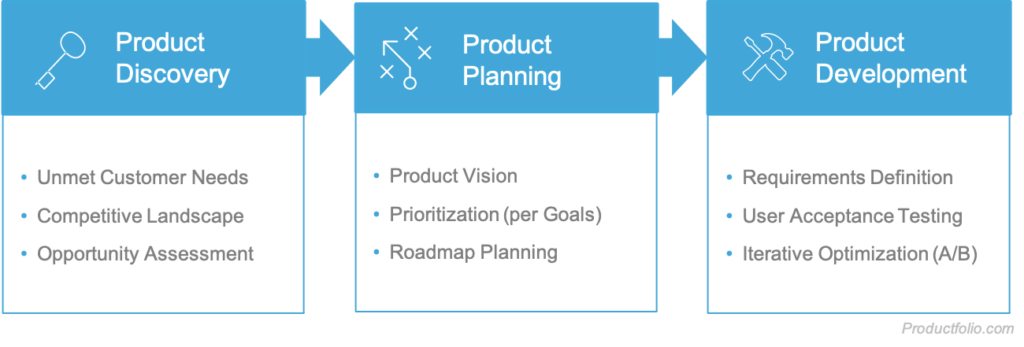Three Pillars of Product
Product Management is a strategic role within an organization that deals with developing and bringing products to the market. It covers everything from idea generation and verification to planning, developing, and marketing a product. This role concerned primarily with delivering value to customers, which is how a company makes money. It is about solving problems confronting the user. Essentially, product management (led by a Product Manager) must understand users’ needs, identify opportunities, and direct the creation (and improvement of) products that solve for users.

As first imagined by Neil McElroy at Procter & Gamble back in the 1930s, product management should be about determining the product-market fit or the right product to develop and efficiently steering the development process. Things aren’t always that simple these days, however. Some distortions can be observed in what people think the role should be about. You could, for instance, find organizations where product management is expected to do what rightly falls under program management.
The Three Pillars of Product framework by Neal Cabage helps to cut through the confusion. It identifies the three primary areas of focus for product management, namely:
- Product discovery
- Product Planning
- Product Development
Product Discovery
Also referred to as Opportunity Discovery, this is about determining what to build. This is probably the most important responsibility of product management. The success of whatever solution you create hinges greatly on this. Major activities in this area include user research and opportunity evaluation. The product manager tries to find out new opportunities or identify exciting ideas that could lead to something great. They do this mainly by interacting with customers to get their feedback while also paying close attention to competing products.
Product discovery is about initiatives or ideas that are user- or customer-centered. Other stakeholders may have some great ideas to proffer, but those that matter most are the ones that help to create value for the customer. Good product management helps to ensure that product discovery runs efficiently. It steers developers toward creating value for customers rather than just working away on ideas coming from internal stakeholders.
Product Planning
This has to do with conceptualizing or imagining what the product will look like. What solution suits the opportunity that has been identified? Without proper planning, an excellent idea can easily result in a poor product.
Key activities in product planning include creating a compelling product vision and developing a roadmap. Product managers and teams develop a vision that sets the goals and direction for the product. This vision is a foundation stone of the product strategy, which describes how the identified goals would be achieved. Product planning links back to product discovery. The research efforts made in that other stage sets the tone for the product strategy. They help to understand the customer and the market, thus enabling teams to determine what strategy would work best.
Ideas or key initiatives that could help achieve the product vision are prioritized and then included on a roadmap. The strategic document provides a simple tool for team and stakeholder alignment – something everyone can look at and be updated on the vision, goals, and current status. A roadmap is an invaluable guide for successful product development.
Product Development
Product managers bring together here everything done in product discovery and planning stages to try and create a valuable product. Some people, especially the uninitiated, think this is the primary concern of product management – it’s obviously not.
Product development starts with the writing of requirements or user stories and the definition of the acceptance criteria. Product creates a backlog – a prioritized list of initiatives or work – from the product roadmap to show what might be required to execute the strategic plan or achieve an outcome.
The backlog is used to create a development plan. This shows how the process of developing the product will run in a step-by-step fashion. Product development activities also include user acceptance testing (UAT), post-launch testing, and application of user feedback to optimize the product.